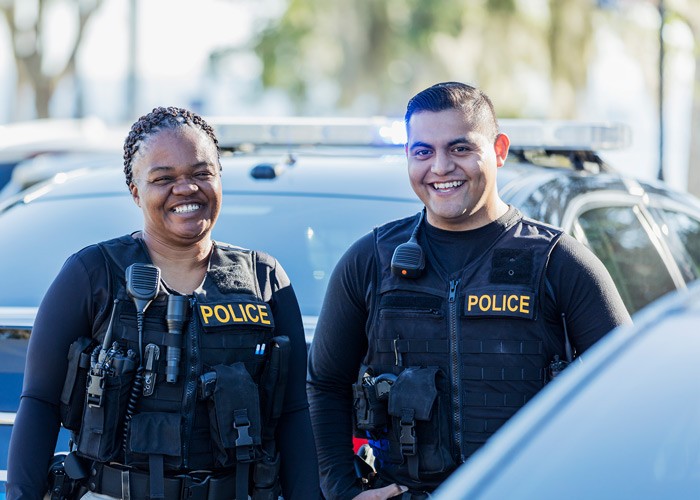Trust between police and the communities they serve is essential for effective law enforcement and public safety. However, recent years have seen declining confidence in law enforcement among segments of the population. As we move into 2024, rebuilding trust will require proactive efforts by police departments to engage their communities, advance training and accountability measures, and leverage technology for positive change.
Current State of Law Enforcement Trust
Multiple polls and surveys indicate that public trust in police has dropped substantially in recent years. A 2022 Pew Research study found that confidence in police fell from 67% in 2016 to 45% in 2022. This distrust was most pronounced among Black and Hispanic adults, with only 19% of Black adults reporting confidence in police.
Contributing factors include high-profile incidents of police misconduct and excessive force, as well as broader critiques of systemic racism in the criminal justice system. While the reasons are complex, it is clear that segments of the community feel unsafe and unprotected by the very institutions meant to serve them. Rebuilding this lost trust must be a priority.
The Importance of Community Engagement
Experts widely agree that community engagement initiatives are critical for improving police-community relations. By interfacing directly with residents, police can better understand community concerns, share information, and collaborate on solutions.
For example, the Chicago Police Department’s Community Policing program trains officers on engagement strategies while also hosting community events like basketball games and block parties. Early analysis shows improved satisfaction in policed neighborhoods. More departments should look to Chicago as a model.
Data-driven approaches can also help target engagement efforts. Minneapolis used geospatial analysis of crime data and community input to pinpoint “hot spots” in need of tailored outreach. Strategically concentrated efforts like these make the best use of limited resources.
Advancements in Police Training and Accountability
While community engagement focuses outward, revamping internal systems is equally important for changing policing culture.
Modern training approaches emphasize de-escalation and nonviolent resolution, equipping officers with the interpersonal skills to defuse tensions. For example, the Survival, Evasion, Resistance, and Escape SERE methodology applies military survival school techniques to high-stress civilian scenarios. Early adopters have seen use-of-force drop by over 30%.
Meanwhile, accountability measures like body cameras and oversight boards provide transparency around officer conduct. A 2022 study on seven police departments found that introducing body cameras led to a 37% decline in civilian complaints.
Technology and policy innovations must continue to bolster accountability while supporting the challenging work of frontline officers.
Technology in Policing
Beyond body cameras, new technologies offer expanded opportunities to connect police with communities:
- Social media platforms enable direct engagement with residents in real-time. Departments can share updates, field questions, and humanize officers.
- Mobile apps like Nextdoor facilitate localized communication to coordinate patrols and exchange crime prevention tips.
- Data analytics tools aggregate datasets on complaints, citations, response times, and more to identify problems and drive reforms.
Used thoughtfully, technology can rebuild the personal connections at the heart of community policing.
Introducing Officer Survey
One innovative new platform is Officer Survey, an online community engagement tool for police departments.
With Officer Survey, departments can conduct secure community surveys, polls, and internal employee surveys to gather feedback and insights. Backed by powerful data analytics, it generates reports on community needs, concerns, and satisfaction levels across various demographics and regions.
Uniquely, Officer Survey focuses not just on whether an interaction was satisfactory, but on the deeper “why” behind community perceptions. This granular feedback is invaluable for enhancing policing strategies.
Impact of Officer Survey on Community Relations
By facilitating regular community surveys, Officer Survey fundamentally embeds community input into police operations. The platform equips departments to:
- Gauge current public sentiment to identify friction points
- Collect input on policies and programs before implementation to maximize buy-in
- Establish open channels for residents to voice concerns, share ideas, and get involved
- Monitor impact over time with longitudinal surveys to track progress
For example, a recent community survey in Springfield helped the department pinpoint downtown pedestrian safety as a top concern. In response, the department adjusted patrol assignments and collaborated with local nonprofits on a pedestrian safety education campaign.
Individual Officer Feedback Through Interaction Surveys
While community surveys provide the big picture, Officer Survey’s unique Interaction Surveys deliver targeted feedback tied to individual officers.
After every police interaction, community members can scan a QR code or receive an SMS text to take a brief survey on that specific encounter. Departments can customize questions and tie responses directly to the officer involved via their anonymous ID number.
With consistent participation, this builds an invaluable dataset showing each officer’s strengths and weaknesses in communicating, de-escalating, exercising empathy, and more. Supervisors can then tailor training and mentoring to the needs of each officer.
Early clients have seen response rates over 60% and dramatic improvements in officer conduct within months. By methodically gathering community perspectives, Officer Survey drives rapid enhancements to policing strategies and community relations.
Conclusion
Public confidence in law enforcement has eroded in recent years, requiring urgent efforts to rebuild trust. As police departments embrace community engagement initiatives, cutting-edge training, robust accountability measures, and innovative technologies like Officer Survey, they can foster the transparency, dialogue, and responsiveness at the heart of healthy police-community relations.
While the path forward holds challenges, collaborative initiatives focused on listening to and serving the public provide hope for restoring confidence and unity. By empowering both residents and police with new channels of understanding, we can build safer and more just communities for all.
Frequently Asked Questions
How does Officer Survey ensure anonymity for community members?
Officer Survey safeguards respondent anonymity through encrypted data transmission and storage. Names are never collected, and demographic data cannot be tied to individual responses.
What steps do departments take to encourage participation?
Strategies include social media outreach, signage directing to surveys, and officers handing out info cards with QR codes and SMS. High response rates are attainable with consistent encouragement.
Does Officer Survey impact officer morale?
While officers may be hesitant at first, departments find that transparent civilian feedback and tailored training are ultimately empowering and appreciated. Surveys focus on constructive input, not criticism.
What analytics does Officer Survey provide?
The dashboard displays aggregate and filterable data on response rates, satisfaction levels, concerns by location/demographic, individual officer performance, and more. Departments get real-time insights to guide reforms.
How does Officer Survey benefit smaller departments?
Officer Survey is cost-effective even for smaller departments. The platform is turnkey and user-friendly, with onboarding support. Intuitive analytics make gleaning insights simple.
How does the Interaction Survey avoid retaliation against respondents?
Surveys are 100% anonymous – no names or other identifiers are collected. The ID-number system prevents officers from tying feedback to specific community members. Strict anti-retaliation policies are also enforced.
Does Officer Survey integrate with existing department data systems?
Yes, Officer Survey can integrate with RMS, CAD, HR databases, and other systems via API to correlate survey data with incident details. This enables even deeper analysis.
What options are available for gathering survey responses?
In addition to QR codes, departments can send email/text invitations to participate.
How long have police departments been using Officer Survey?
Officer Survey was developed in 2019 and piloted in 2020. Over 100 departments across the country now use the platform. Case studies showcase proven results.
How does Officer Survey simplify data collection?
Officer Survey removes the complex logistics of conducting recurring surveys via an easy-to-use platform. Survey design, deployment, monitoring, and analysis are all handled seamlessly.
Does the platform offer technical support?
Yes, onboarding and ongoing support are provided, including resources like live chat, knowledge base articles, remote digital training, and a customer success team.
What security measures protect sensitive data?
Military grade AES-256 encryption, 2-factor authentication, and stringent access controls safeguard all data.
How are costs managed for a department’s budget?
Pricing scales based on population served to meet any budget. Volume discounts are also available. Grants often cover costs due to Officer Survey’s strong ROI.
How can Officer Survey aid with mandatory reporting?
The data aids in required DOJ reporting on use of force, misconduct complaints, community perceptions, and more. Streamlined reporting saves departments time.
How does the platform simplify data analysis?
Intuitive dashboards and filtering make gleaning actionable insights from survey data easy. Analysts spend less time processing data and more time enacting reforms.
Can Officer Survey help us with CALEA accreditation requirements?
Yes, per CALEA 45.2.2 Citizens Survey is one of the mandatory requirements.






